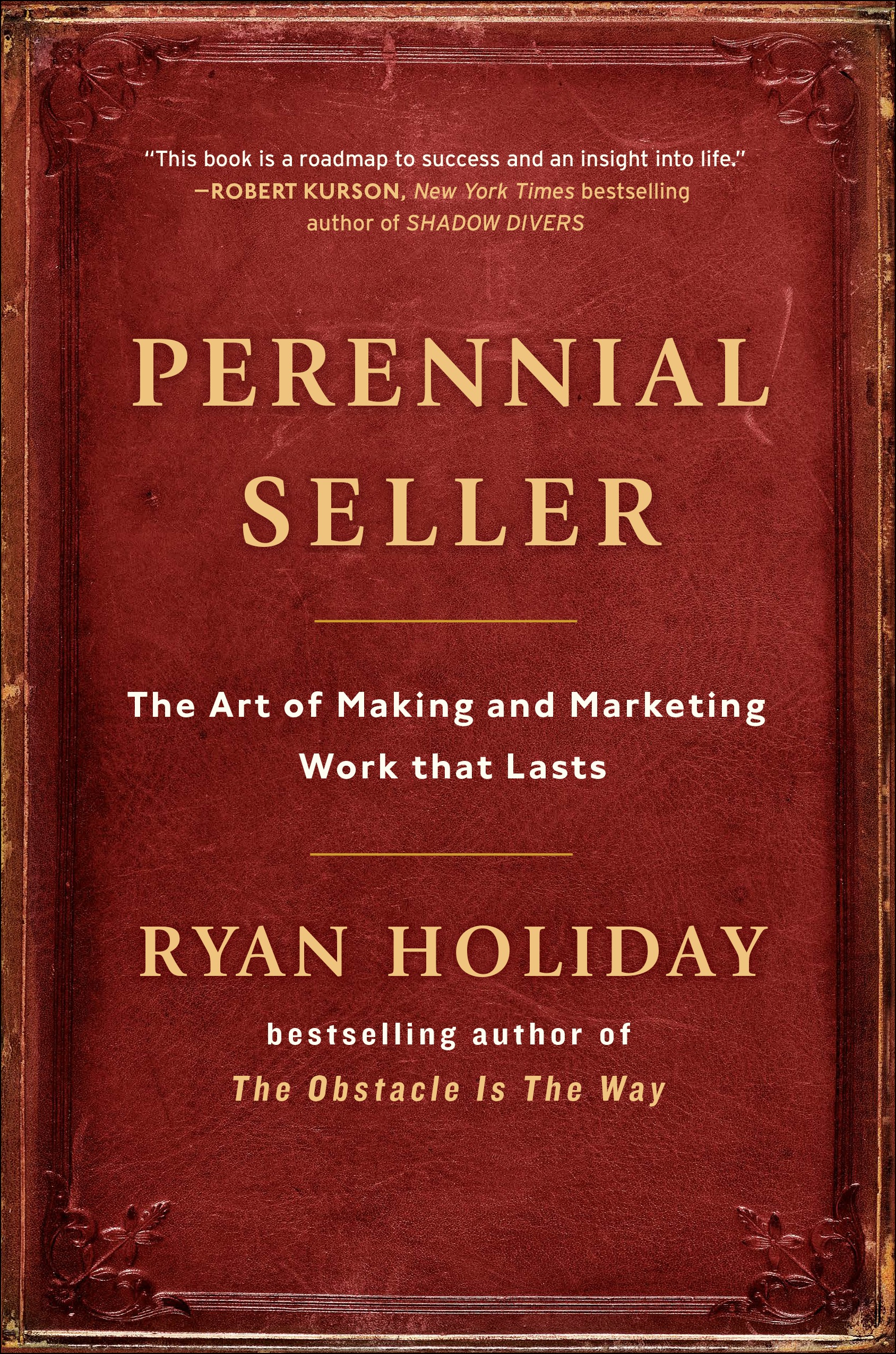
How did a movie like The Shawshank Redemption gross more than US$100 million even though it stank at the box office?
What can you do to develop an evergreen product or service — one that continually generates income years after its launch?
Thanks to The Perennial Seller by Ryan Holiday (he also wrote Growth Hacker Marketing), we now have a framework to build and market everlasting products and services.
Targeted at artists, creators and serial-entrepreneurs, The Perennial Seller suggests that perennial sellers are not just accidental occurrences. Rather, they’re the result of specific strategies, tactics and habits adopted by perpetual sellers (aka evergreen classics).
Peppered with case studies and examples — from movies, art, books, songs, video games to sports and businesses — the book covers the four stages of developing, rolling out and marketing evergreen sellers.
These stages are:
- The creative process of building an everlasting product
- How to position, package and polish your perennial seller
- Ways to market a perpetually selling product
- Strategies you can use to build a timeless platform
Let us look at each of these strategies in turn.
#1 How to Create a Perennial Product
Most creators of perennial products do not just come up with a gazillion ideas. On the contrary — and I’m a huge believer in this — ideas are cheap and easy.
It is the making of the work which is valuable.
In thinking about your creative process, consider what your purpose for doing so is.
Why are you creating your product or service? What motivates and drives you to do so?
More importantly, what will you sacrifice to achieve your goal?
Consider it as a marathon and not a sprint. Put in the time to do the timeless work that matters.
As Jeff Bezos of Amazon famously told his employees: “Focus on the things that don’t change.”
A good way to do so is to solve a perpetual problem or to identify universal and timeless themes in your work.
For example, George Lucas was actually inspired by the work of Joseph Campbell called the “hero’s journey” (I covered it in this article) when he created Star Wars — the story of Luke Skywalker is rooted in similar epic principles to Gilgamesh, Homer and even Jesus Christ.
Finally, consider thinking about who you’re creating for (hint: it shouldn’t be everybody), what it does for them, and yes, what is the “dent in the Universe” which you hope to achieve?
#2 Positioning and Packaging
No man is an island — even if you’re a starving artist or a homeless author willing to sacrifice all to pursue purity in your art.
In thinking about how you should position your evergreen seller, consider working with editors to improve your work.
Let them vet your baby. Don’t be afraid to “kill your darlings” as Stephen King so aptly written.
Beyond polishing and perfecting, consider using Holiday’s One Sentence, One Paragraph, One Page strategy.
Here’s how it works:
- Put your beta version of your product (website, manuscript, etc) aside
- Open a blank document
- Describe what your project is. Is it a book? A movie? A building? A company? A product? A song?
- With fresh eyes, try to write out what your project is supposed to be and to do in one sentence, one paragraph, and then one page
- Try to do this using a third person perspective
Consider asking these questions when you craft your positioning statement:
- Who is this for?
- Who is this not for?
- Why is it special? What will it do for them?
- Why should anyone care?
Consider who your target audience is by writing a statement like this:
“This is a ______ that does ________ for ______ because _________.”
For example, here’s mine:
“Cooler Insights employs the best practices in content marketing for marketers and entrepreneurs to help them to meet the challenges of the digital and social age.”
Oh yes, it is important to also think about commercialising your art. Without a means of generating revenue, you can’t be a perennial seller or creator.
#3 Evergreen Marketing Strategies
Like it or loathe it, marketing of your classic work is the creator’s job.
It cannot simply be outsourced completely away — you’ll still need to oversee and control how the different pieces fit together.
Anything can be marketing — from hustling at events and exhibitions, knocking on doors, to pushing out flyers.
A key thing here is to generate word of mouth in your marketing efforts. This means that you should find ways to make your product or service go viral.
Interestingly, a study by McKinsey (quoted from the book) revealed that 20 percent to 50 percent of all purchasing decisions happen from some version of word of mouth. Wow.
A good way to generate word of mouth? Give away your product for free!
(Or if you can’t, at least to make it cheap.)
The other thing you should consider is to ask yourself this: “What do we have to work with?”
Put together a list of all your contacts, relationships, resources, and potential advertising budget to get the word out.
You should also consider how you can find your influencers. These could be individuals whom you network with — 4-Hour Work Week author Tim Ferriss used to attend conferences and events throughout the US just to network with the right people.
When you find them, do not just ask them for favours. Rather seek ways to provide value to these influencers first — for example, you can send designs of your product or samples to interest them or even complete products.
Do also use social proof such as the number of pre-orders for your products, testimonials and reviews, or media mentions to distinguish yourself from all the others asking them for favours.
Talking about media, Holiday suggests that you could start small by pitching smaller niche media channels. Or provide free items to your targeted KOLs (Key Opinion Leaders) and use that to get the buzz going.
Finally, consider pulling together publicity stunts or adopt newsjacking to generate publicity.
#4 Building a Perpetually Selling Platform
To turn your perennial product into a full-fledged career, you’ll need to build your own platform.
According to Holiday, a platform can be defined as follows:
“…a platform is the combination of the tools, relationships, access, and audience that you have to bear on spreading your creative work — not just once, but over the course of a career.”
This could be your network of social media followers, as well as your friends, your body of work, plus the community that your work exists in. It could also be your website.
Your platform could also be influencers that you know, your email list, as well as intangible assets like the trust you’ve built, your reputation and sources of income.
In the case of former British leader Winston Churchill, his platform included some 10 million words that he made his living by as a writer. Hence Churchill’s books, newspaper columns, and radio appearances form part of his platform.
What about superstar Lady Gaga? Well, her platform included her “Little Monsters”— die-hard fans who hang on to her every word.
And if you’re successful in making your evergreen bestseller a platform, you may wish to turn it into an empire. No, I’m not talking about Star Wars or the British Empire, but about spinning off related products and services (eg fashion for hip-hop artists) and working with other creatives to grow your influence.
Building Your Email List
A key takeaway from the book, building your email list helps you to immunize your perpetual business from the vagaries of the social media world.
This was what heavy metal group Iron Maiden did, and it helped them to stay relevant through the decades. Through your email list, you’re able to directly and regularly communicate with your supporters and avoid being dis-intermediated by disruptions in technology platforms.
To grow your list, consider the following strategies:
- Giveaways—freebies are often welcomed and this can be a guide, an excerpt from your book, a free song, coupon, or other premiums
- Create a gate/ opt-in—use a plug-in to create an opt-in form for people to access your giveaway
- Pop-ups—these are useful to collect email addresses on your website
- Manual during events—collecting name-cards or asking people to write down their names and emails and mobile numbers still work
- Run contests—these can be both online or offline
- Offer an ongoing service—consider providing useful tips and information that your target audience would value
- Post online—use all your available channels to invite subscription—your emails, social media posts, instant messages, or other channels.
Conclusion
Heard of the 1,000 true fans theory? Crafted by Kevin Kelly formerly from Wired magazine, it states that if you have 1,000 true fans for your work—fans who are willing to buy whatever you produce and support your business—you’d be able to make a decent living as a creator.
If you think that is tough, then perhaps the role of making evergreen products and marketing them isn’t for you.
Quoting from the book:
“When it comes to making your art—whether it’s music or writing or building a great company—you either really want it or you don’t. There is no easy way in, or out.”
Let me know if these ideas on achieving immortality (or at least near-permanence) for your products or services resonate with you.

